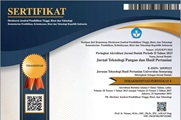Nutritional Value and Sensory Properties of Brown Rice Flour Cookies with Green Spinach (Amaranthus Tricolor L.) Incorporation as Gluten-Free Food Alternative
Abstract
Keywords
Full Text:
PDFReferences
Ardin, L., Karimuna, L. and Amrullah, P.M. (2019). Formulasi tepung cangkang telur dan tepung beras merah terhadap nilai kalsium dan organoleptik kue karasi. Jurnal Sains dan Teknologi Pangan, 4(1), 1892 1904.
Ashtari, S., Najafimehr, H., Pourhoseingholi, M.A., Rostami, K., Asadzadeh-Aghdaei, H., Nejad-Rostami, M., Tavirani, M.R., Olfatifar, M., Makharia, G.K., and Zali, M.R. (2021). Prevalence of celiac disease in low and high risk population in Asia Pacific region: A systematic review and meta-analysis. Sci Rep 11, 2383 DOI: https://doi.org/10.1038/s41598-021-82023-8
Bolarinwa, l.F., Lim, P.T., and Kharidah, M. (2018). Quality of gluten-free cookies from germinated brown rice flour. Food Research, 3(3), 199-207. DOI: https://doi.org/10.26656/FR.2017.3(3).228
Cairano, M.D., Galgano, F., Tolve, R., Caruso, M.C., Condelli, N. (2018). Focus on gluten free biscuits: ingredients and issues. Trends in Food Science & Technology, 81, 203-212. DOI: https://doi.org/10.1016/j.tifs.2018.09.006
Cummins A.G. & Roberts-Thomson, I.C. (2009). Prevalence of celiac disease in the Asia-Pacific region. Canadian Journal of Gastroenterology and Hepatology, 24(8), 1347-51. DOI: https://doi.org/10.1111/j.1440-1746.2009.05932.x
Dhillon, B., Sodhi, N.S., Aneja, E., Kumar, A., Jaiswal, S. (2021). Physico-chemical and textural (sensorial and electromyographic) evaluation of cookies formulated using different ratios of brown rice flour and refined wheat flour. Journal of Food Measurement and Characterization, 15(1), 219 227. DOI: https://doi.org/10.1007/s11694-020-00625-8
Gobbetti, M., Pontonio, E., Filanninob, P., Rizzellob, C.G., De Angelis, M., and Di Cagnoa, R. (2018). How to improve the gluten-free diet: The state of the art from a food science perspective. Food Res. Int., 110, 22 32. DOI: https://doi.org/10.1016/j.foodres.2017.04.010
Guennouni, M., El Khoudri, N., Bourrhouat, A., and Hilali, A. (2020). Nutritional quality of gluten-free products in Moroccan supermarkets and e-commerce platforms. Cereal Chemistry, 97(5), 912-920. DOI: https://doi.org/10.1002/cche.10313
Herawati, B.R.A., Suhartatik, N., and Widayanti, Y. A. (2018). Cookies tepung beras merah (Oryza nivara) mocaf (modified cassava flour) dengan penambahan bubuk kayu manis (Cinnamomun burmanni) . Jurnal Teknologi dan Industri Pangan, 3(1), 33 40.
Herni, S., Tamrin, and Asyik, N. (2018). Penilaian organoleptik serta proksimat biskuit tinggi serat berbasis tepung kaopi fermentasi dan ampas kelapa. Journal Sains dan Teknologi Pangan, 3(3), 1379 1392.
Islam, M., Taneya, M., Shams-Ud-Din, M., Syduzzaman, M., & Hoque, M. (2012). Physicochemical and functional properties of brown rice (Oryza sativa) and wheat (Triticum aestivum) flour and quality of composite biscuit made thereof. The Agriculturists, 10(2), 20 28. DOI: https://doi.org/10.3329/agric.v10i2.13135
Jaswir, I., Rahayu, E.A., Yuliana, N.D., and Roswiem, A.P. (2020). Daftar referensi bahan-bahan yang memiliki titik kritis halal dan substitusi bahan non-halal. Jakarta: Komite Nasional Ekonomi dan Keuangan Syariah.
Kuhns E., and Coulter, K. (2009). The effect of replacing white flour with brown rice flour in chocolate chip cookies.
Mir, S.A., Bosco, S.J.D., Shah, M.A., Santhalakshmy, S., and Mir, M.M. (2017). Effect of apple pomace on quality characteristics of brown rice based cracker. Journal of the Saudi Society of Agricultural Sciences, 16(1), 25-32. DOI: https://doi.org/10.1016/j.jssas.2015.01.001
Morita, N., Maeda, T., Watanabe, M., and Yano, S. (2007) Pre-germinated brown rice substituted bread: Dough characteristics and bread structure. International Journal of Food Properties, 10, 779-789. DOI: https://doi.org/10.1080/10942910601183643
Naqash, F., Gani, A., Gani, A., Masoodi, F.A. (2017). Gluten free baking: Combating the challenges A review. Trends in Food Science and Technology, 66, 98-107. DOI: https://doi.org/10.1016/j.tifs.2017.06.004
Octaviyanti, N., Dwiloka, B., and Setiani, B. E. (2017). Mutu Kimiawi dan Mutu Organoleptik Kaldu Ayam Bubuk dengan Penambahan Sari Bayam Hijau. Jurnal Aplikasi Teknologi Pangan, 6(2), 2 5.
Patricia, O., Zoue, L., Megnanou, R.-M., Doue, R., & Niamke, S. (2014). Proximate composition and nutritive value of leafy vegetables consumed in northern C ´te D ivoire. European Scientific Journal, 10(6), 212-227. DOI: https://doi.org/10.19044/esj.2014.v10n6p%p
Plugis N.M. & Khosla, C. (2015). Therapeutic approaches for celiac disease. Best Pract Res Clin Gastroenterol., 29(3), 503-21. DOI: https://doi.org/10.1016/j.bpg.2015.04.005
Rasyid, N., Hartono, R., and Sunarto. (2020). Daya terima serta analisis kadar protein dan fosfor pada nugget cumi-cumi dengan penambahan bayam. Media Kesehatan Politeknik Kesehatan Makassar, 8153, 147 157.
Sabila, M., Siter, I.K., Timur, P.I. (2020). Pengaruh perbandingan tepung terigu dan tepung beras merah (Oryza nivara) terhadap karakteristik kue lumpur. Jurnal Ilmu dan Teknologi Pangan (ITEPA), 9(2), 161-169. DOI: https://doi.org/10.24843/itepa.2020.v09.i02.p06
Sreerama, Y.N., Sashikala, V.B., Pratape, V.M., and Singh, V. (2012). Nutrients and antinutrients in cowpea and horse gram flours in comparison to chickpea flour: Evaluation of their flour functionality. Food Chem., 131, 462 468. DOI: https://doi.org/10.1016/j.foodchem.2011.09.008
Susilawati, B.S., Syam, H., and Fadhilah, R. (2018). Effect of modified pragelatinization corn flour on quality cookies. Jurnal Pendidikan Teknologi Pertanian, 4, 27-48.
Syafitri, S., Priawantiputri, W., and Dewi, M. (2019). Produk biskuit sumber zat besi berbasis bayam dan tepung sorgum sebagai makanan tambahan ibu hamil. Jurnal Riset Kesehatan Poltekkes Depkes Bandung, 11(2), 13 21.
Walker, R., Tseng, A., Cavender, G., Ross, A., Zhao, Y. (2014). Physicochemical, nutritional, and sensory qualities of wine grape pomace fortified baked goods. J. Food Sci., 79, 1811 €”1822. DOI: https:// doi.org/10.1111/1750-3841.12554
Yudhistira, B., Sari, T. R. and Affandi, D. R. (2019). Karakteristik fisik, kimia dan organoleptik cookies bayam hijau (Amaranthus tricolor) dengan penambahan tomat (Solanum lycopersicum) sebagai upaya pemenuhan defisiensi zat besi pada anak-anak. Warta Industri Hasil Pertanian, 36(2), 83-95. DOI: https://10.32765/wartaihp.v36i2.5286
DOI: http://dx.doi.org/10.26623/jtphp.v18i1.6110
Refbacks
- There are currently no refbacks.
Published :
Faculty of Agricultural Technology, Universitas Semarang
Jl.Soekarno-Hatta, Tologosari, Semarang, Indonesia, Telp: 024-6702757, Fax: 024-6702272, e_mail : jurnal_tphp@usm.ac.id.

This is licensed under a Creative Commons Attribution 4.0 International License.











